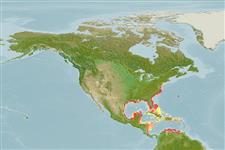Bivalvia |
Cardiida |
Donacidae
Environment: milieu / climate zone / Mức độ sâu / distribution range
Sinh thái học
; Thuộc về nước lợ; Mức độ sâu 0 - 11 m (Tài liệu tham khảo 83435). Subtropical; 42°N - 10°N, 98°W - 63°W
Western Atlantic: North America, from New York to Texas and Mexico, throughout the Gulf of Mexico. The Sea of Marmara and the Mediterranean: Introduced in Egypt and Turkey. Tropical to subtropical.
Length at first maturity / Bộ gần gũi / Weight / Age
Chín muồi sinh dục: Lm ? range ? - ? cm Max length : 1.9 cm DL con đực/không giới tính; (Tài liệu tham khảo 83435); Tuổi cực đại được báo cáo: 1.00 các năm (Tài liệu tham khảo 8702)
Found in the intertidal zone on coarse-grained (Ref. 104171) sandy beaches (Refs. 104348, 104171). Some migrate up and down the beach with the tides (Ref. 104348). Actively migrates by jumping out of the sand and riding specific waves (Ref. 104171). Filter-feeder (Ref. 104245). Feeds on phytoplankton, algae, detritus, bacteria and other small suspended particles via its short siphons (Ref. 104246).
Life cycle and mating behavior
Chín muồi sinh dục | Sự tái sinh sản | Đẻ trứng | Eggs | Sự sinh sản | Larvae
Semelparous species (Ref. 104352). Members of the class Bivalvia are mostly gonochoric, some are protandric hermaphrodites. Life cycle: Embryos develop into free-swimming trocophore larvae, succeeded by the bivalve veliger, resembling a miniature clam (Ref. 833).
Bisby, F.A., M.A. Ruggiero, K.L. Wilson, M. Cachuela-Palacio, S.W. Kimani, Y.R. Roskov, A. Soulier-Perkins and J. van Hertum 2005 Species 2000 & ITIS Catalogue of Life: 2005 Annual Checklist. CD-ROM; Species 2000: Reading, U.K. (Tài liệu tham khảo 19)
IUCN Red List Status
(Tài liệu tham khảo 130435: Version 2025-1)
CITES status (Tài liệu tham khảo 108899)
Not Evaluated
CMS (Tài liệu tham khảo 116361)
Not Evaluated
Threat to humans
Human uses
Các nghề cá: Các nghề cá là sinh kế
| FishSource |
Các công cụ
Thêm thông tin
PhysiologyThành phần ô-xy
Human RelatedStamps, coins, misc.
Các nguồn internet
Estimates based on models
Preferred temperature
(Ref.
115969): 23.4 - 28, mean 26.8 (based on 348 cells).
Fishing Vulnerability
Low vulnerability (10 of 100).
